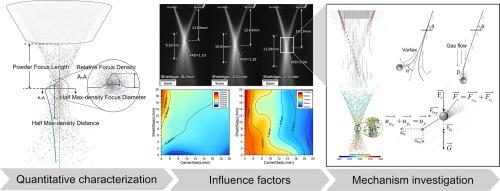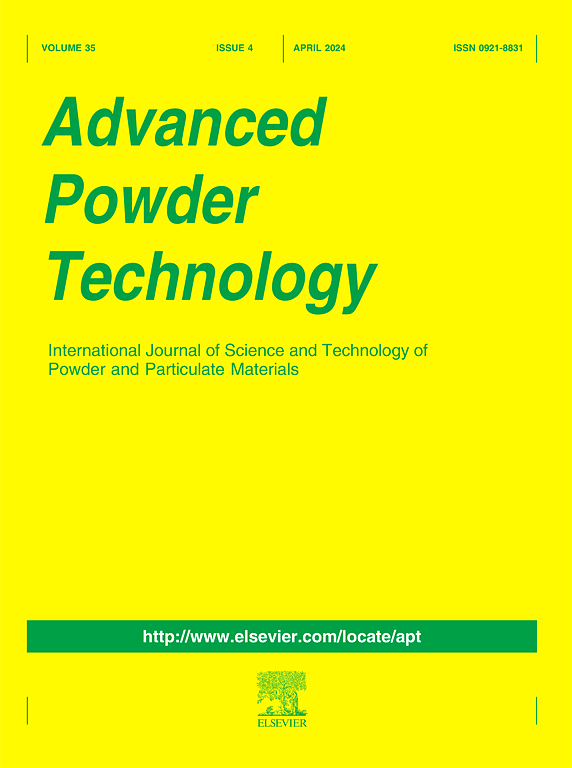Monitoring of powder flow focus in laser metal deposition: experimental and numerical analysis of gas-powder interaction mechanisms
IF 4.2
2区 工程技术
Q2 ENGINEERING, CHEMICAL
引用次数: 0
Abstract
The powder flow focus is critical in determining the quality of Powder-based Laser Metal Deposition (LMD-p). However, systematic studies on the monitoring of powder focus remain limited. To address this, the influence of in-process parameters and the underlying physical mechanisms was comprehensively investigated by combining the optical measurement experiments and CFD-DEM two-way coupling simulations in this study. Four quantitative descriptors were introduced to describe the spatial distribution of powder focus: Powder Focus Length (PFL), Relative Focus Density (RFD), Half Max-Density Focus Diameter (HMFD), and Half Max-Density Distance (HMD). The results demonstrate that the powder focus is synergistically influenced by the Shieldgas, Carriergas and powder feeding rate. Adjusting the coaxial shielding gas can effectively regulate the focal position by about 21.4 % (2.5 mm) without affecting focus distribution. Increasing the Carriergas enhances the convergence of the powder flow and improves focus position stability. A higher powder feeding rate results in a larger HMFD and RFD of powder focus, which also provides a greater HMD for the stand-off distance from the nozzle. The influencing mechanisms of gas on powder flow dynamics were further analyzed, and the initial velocity as well as gas flow field were found to be the key factors that influence the powder flow dynamics.

激光金属沉积中粉末流动焦点的监测:气-粉相互作用机理的实验与数值分析
粉末流焦点是决定粉末基激光金属沉积(LMD-p)质量的关键。然而,对粉末聚焦监测的系统研究仍然有限。为了解决这一问题,本研究结合光学测量实验和CFD-DEM双向耦合模拟,全面研究了过程中参数的影响及其潜在的物理机制。采用粉末聚焦长度(PFL)、相对聚焦密度(RFD)、半最大密度聚焦直径(HMFD)和半最大密度距离(HMD)四个定量描述符来描述粉末聚焦的空间分布。结果表明:气体、气体和粉末加料速率对粉末聚焦有协同影响。调节同轴保护气体可在不影响焦点分布的情况下有效调节焦点位置约21.4% (2.5 mm)。增加载流系数增强了粉末流动的收敛性,提高了焦点位置的稳定性。更高的粉末进给率导致更大的粉末焦点的HMFD和RFD,这也为与喷嘴的距离提供了更大的HMD。进一步分析了气体对粉末流动动力学的影响机理,发现初始速度和气体流场是影响粉末流动动力学的关键因素。
本文章由计算机程序翻译,如有差异,请以英文原文为准。
求助全文
约1分钟内获得全文
求助全文
来源期刊

Advanced Powder Technology
工程技术-工程:化工
CiteScore
9.50
自引率
7.70%
发文量
424
审稿时长
55 days
期刊介绍:
The aim of Advanced Powder Technology is to meet the demand for an international journal that integrates all aspects of science and technology research on powder and particulate materials. The journal fulfills this purpose by publishing original research papers, rapid communications, reviews, and translated articles by prominent researchers worldwide.
The editorial work of Advanced Powder Technology, which was founded as the International Journal of the Society of Powder Technology, Japan, is now shared by distinguished board members, who operate in a unique framework designed to respond to the increasing global demand for articles on not only powder and particles, but also on various materials produced from them.
Advanced Powder Technology covers various areas, but a discussion of powder and particles is required in articles. Topics include: Production of powder and particulate materials in gases and liquids(nanoparticles, fine ceramics, pharmaceuticals, novel functional materials, etc.); Aerosol and colloidal processing; Powder and particle characterization; Dynamics and phenomena; Calculation and simulation (CFD, DEM, Monte Carlo method, population balance, etc.); Measurement and control of powder processes; Particle modification; Comminution; Powder handling and operations (storage, transport, granulation, separation, fluidization, etc.)
 求助内容:
求助内容: 应助结果提醒方式:
应助结果提醒方式:


